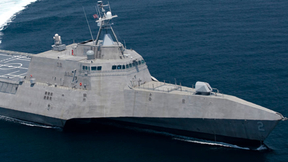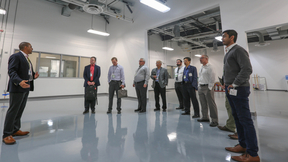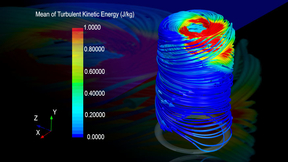Back
Engineering
Research by Lawerence Livermore scientists may help validate organ-on-a-chip devices
A new study in which Lawrence Livermore National Laboratory (LLNL) scientists compared drug responses in the brains of rodents to drug responses of brain cells cultured in Lab-developed "brain-on-a-chip" devices may be a critical first step to validating chip-based brain platforms, LLNL researchers said. In the study, published online today in the journal Scientific…
Warhead life extension passes key milestone
The program to extend the life of the W80 nuclear warhead recently achieved a significant milestone when the National Nuclear Security Administration (NNSA) gave passing grades to the plans to refurbish certain components and the proposed approach to developing component cost estimates. Passing the milestone confirms that the life extension program (LEP), dubbed the W80-4…
Former LLNL engineer turned NASA astronaut inspires employees to 'reach for the stars'
Growing up in the Central Valley, the son of Mexican migrant farmworkers, José Hernández learned early on that education would be his ticket out of a life toiling in the fields. His journey would lead him to a 15-year career at Lawrence Livermore National Laboratory (LLNL), to the zero-gravity of low-earth orbit aboard the space shuttle Discovery, and to a congressional…
Lab scientists help develop new tool for faster, more accurate analysis of chemical bonding
In a development with the potential to enable breakthroughs in lithium-ion batteries and further impact a wide swath of research areas, Lawrence Livermore National Laboratory (LLNL) scientists have developed a new open source software application that can, in real-time, compute, analyze and potentially predict the trajectories of atoms during the course of bond breaking…
LLNL joins effort to 3D print parts for U.S. Navy
Researchers at Lawrence Livermore National Laboratory (LLNL) are lending their expertise in metal additive manufacturing to a new collaboration aimed at 3D printing critical replacement parts for the U.S. Navy. The Office of Naval Research recently announced an award of $9 million to fund a collaboration led by GE Global Research and aimed at developing a rapid process for…
Nearly completed Advanced Manufacturing Lab opens doors to industry, academia
Representatives from more than 30 companies in the additive manufacturing (3D printing), automotive and aerospace industries got their first glimpse last week at Lawrence Livermore National Laboratory’s (LLNL) newest facility, the Advanced Manufacturing Laboratory, located in the Livermore Valley Open Campus (LVOC). The sneak preview was part of a "Partnering for Success"…
Additive manufacturing advances K-9 training
Additive manufacturing (AM) has gone to the dogs, thanks to Lawrence Livermore National Laboratory’s (LLNL’s) new approach to K-9 training materials. The process prints 3D objects that contain trace amounts of nonreactive explosives, resulting in several advantages for K-9s and their handlers. Chemist John Reynolds leads a team of LLNL scientists and engineers who recently…
Lab's Data Science Institute brings best minds in AI, machine learning under one umbrella
Machine learning. Deep learning. Artificial intelligence. Computer vision. Big data analytics. These aren’t just techie buzzwords — they’re all areas of research that fall under the sweeping term "data science." So how does a national laboratory, with researchers exploring all of these areas and more, coalesce these disciplines into a unified group? Launched earlier this…
Lab scientists successfully print glass optics
For the first time, researchers at Lawrence Livermore National Laboratory (LLNL) have successfully 3D-printed optical-quality glasses, on par with commercial glass products currently available on the market. In a study published in the journal Advanced Materials Technologies, LLNL scientists and engineers describe successfully printing small test pieces from Lab-developed…
Learning to fly: Lab-sponsored drone competition engages Cal Poly students
The drones whizzed, hovered and soared, racing around a circular "track" and dropping ball-bearings on tarpaulin targets from high above. Four teams, comprised of engineering students from Cal Poly-San Luis Obispo were going head-to-head in a Lawrence Livermore National Lab-sponsored Design Challenge, putting their custom-built drones to the test with scholarships, awards…
Laboratory researchers join their AI-enabled counterparts for 'collaborative autonomy'
A team of firefighters clears a building in a blazing inferno, searching rooms for people trapped inside or hotspots that must be extinguished. Except this isn’t your typical crew. Most apparent is the fact that the firefighters aren’t all human. They’re working side-by-side with artificially intelligent (AI) robots who are searching the most dangerous rooms, and making…
DOE's HPC4Manufacturing program seeks industry proposals for energy advances
The Department of Energy (DOE) on Feb. 1 announced up to $3 million will be available to U.S. manufacturers for public/private projects aimed at applying high performance computing to industry challenges for the advancement of energy innovation. The funding represents the latest round of solicitations for the High Performance Computing for Manufacturing (HPC4Mfg) program,…
Lab unlocks secrets of nanoscale 3D printing
Lawrence Livermore National Laboratory (LLNL) researchers have discovered novel ways to extend the capabilities of two-photon lithography (TPL), a high-resolution 3D printing technique capable of producing nanoscale features smaller than one-hundredth the width of a human hair. The findings, recently published on the cover of the journal ACS Applied Materials &…
LLNL-developed microelectrodes enable automated sorting of neural signals
Thin-film microelectrode arrays produced at Lawrence Livermore National Laboratory (LLNL) have enabled development of an automated system to sort brain activity by individual neurons, a technology that could open the door to recording and analyzing unprecedented amounts of neural signals over time, and, ultimately, provide scientists with new clues about how the brain…
Volumetric 3D printing builds on need for speed
While additive manufacturing (AM), commonly known as 3D printing, is enabling engineers and scientists to build parts in configurations and designs never before possible, the impact of the technology has been limited by layer-based printing methods, which can take up to hours or days to build three-dimensional parts, depending on their complexity. However, by using laser…
Lab researchers achieve breakthrough in 3D printed marine grade stainless steel
"Marine grade" stainless steel is valued for its performance under corrosive environments and for its high ductility -- the ability to bend without breaking under stress -- making it a preferred choice for oil pipelines, welding, kitchen utensils, chemical equipment, medical implants, engine parts and nuclear waste storage. However, conventional techniques for…
LLNL project aims to transform electrical grid resiliency with distributed energy resources
In the event of a major earthquake, hurricane or flood, electricity might be lost for days, affecting communications, recovery efforts and people’s lives. Normally, in a large-scale emergency, distributed energy resources (DERs) -- such as the energy produced by solar panels at customers’ homes -- are shut off to protect the greater electrical grid. But a new project…
Lab researchers achieve '4D printed' material
For the first time, Lawrence Livermore National Laboratory (LLNL) researchers have successfully 3D printed composite silicone materials that are flexible, stretchable and possess shape memory behavior, a discovery that could be used to create form-fitting cushioning activated by body heat, such as in a helmet or shoe. As described in their paper published online by…
LLNL finds reason behind defects in 3D printing
High-speed images of a common laser-based metal 3D printing process, coupled with newly updated computer models, have revealed the mechanisms behind material redistribution, a phenomenon that leads to defects in printed metal parts, Lawrence Livermore National Laboratory (LLNL) researchers reported. In a study published by Scientific Reports, LLNL scientists combined…
Lab loans state-of-the-art 3D printer to Cal Poly
California Polytechnic State University (Cal Poly) San Luis Obispo engineering students now have access to the state-of-the-art in metal additive manufacturing and the ability to perform contracted work for Lawrence Livermore National Laboratory (LLNL), thanks to a new Selective Laser Melting (SLM) machine on loan to the university. LLNL purchased the SLM machine and is…

























